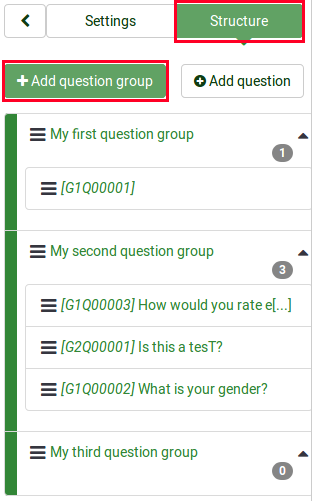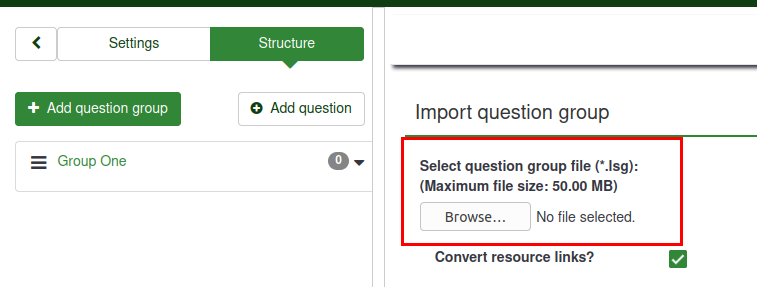Question groups - introduction/es: Difference between revisions
From LimeSurvey Manual
Maren.fritz (talk | contribs) (Created page with "¡Puedes crear tantos grupos como quieras!") |
Maren.fritz (talk | contribs) (Created page with "==Agregar barra de herramientas de grupo de preguntas==") |
||
| Line 45: | Line 45: | ||
== | ==Agregar barra de herramientas de grupo de preguntas== | ||
Encontrarás las siguientes opciones en la barra de herramientas superior: | |||
Revision as of 10:44, 5 September 2023
Crear grupo de preguntas
Los grupos son una excelente manera de organizar sus encuestas colocándolas en categorías (grupos). La forma en que categorices tus encuestas/grupos depende completamente de ti.
Para agregar grupos de preguntas a su encuesta:
(1) Desde la pestaña encuesta estructura de su encuesta, haga clic en +Agregar grupo de preguntas.
Después de hacer clic en Agregar grupo de preguntas, se mostrará el panel Agregar grupo de preguntas.
(2) Complete los campos requeridos.
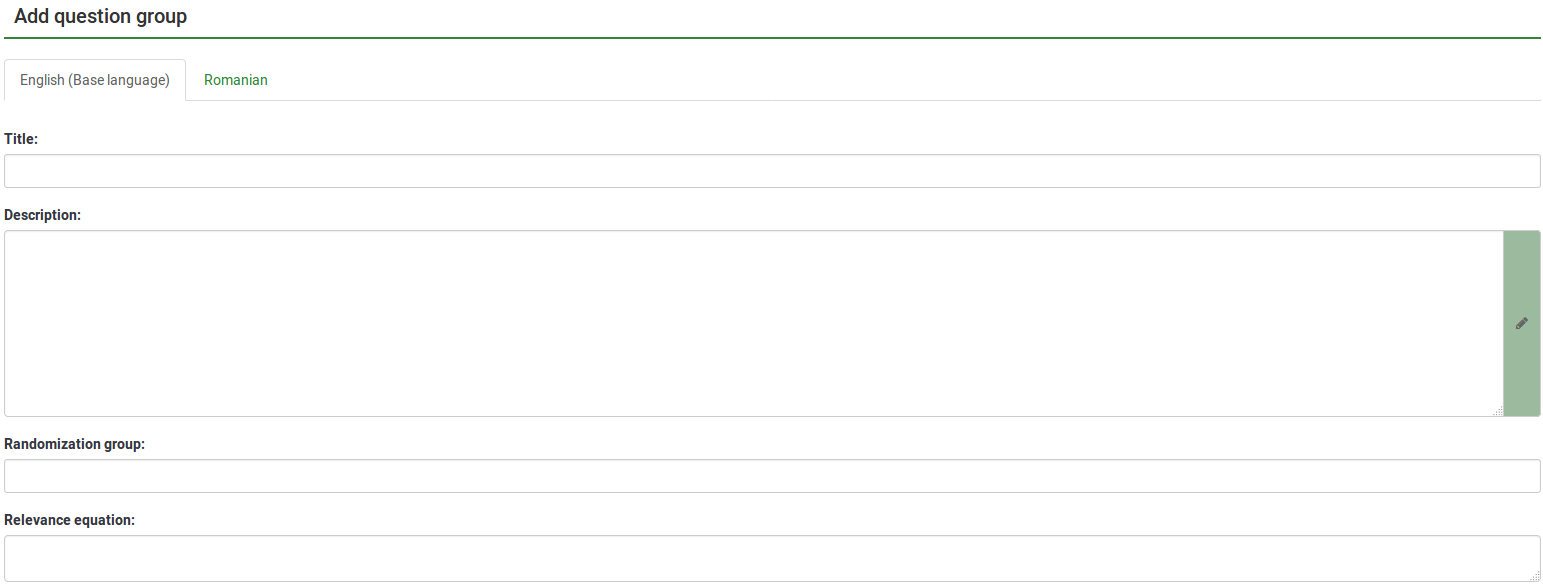
Campos Agregar grupo de preguntas
- Título: Escriba en este cuadro el nombre que desea darle al grupo de preguntas;
- Descripción: Este campo le permite publicar una nota explicativa para cualquier conjunto de preguntas. Si agrega una descripción, se presentará junto con la encuesta antes de comenzar cualquiera de las preguntas de ese grupo. Si no se agrega ningún texto, los participantes públicos simplemente pasarán inmediatamente a las preguntas de la encuesta. Puedes utilizar el editor HTML para incluir imágenes, texto formateado, etc. a tu gusto;
- Grupo de aleatorización: Para comenzar a aleatorizar un grupo de preguntas, ingrese una cadena en el campo como randgroup1. Deberá ingresar esa misma cadena en todos los grupos de preguntas que desee aleatorizar y que luego aparecerán en orden aleatorio al realizar la encuesta. ¡Solo se cambiarán aleatoriamente los lugares dentro del mismo grupo!
- Ecuación de relevancia: Puede establecer una "ecuación de relevancia" en este campo para el grupo con la ayuda de ExpressionScript. Esto es útil para "bucles" u otros casos en los que se repite contenido similar varias veces. Por ejemplo, supongamos que desea hacer el mismo conjunto de preguntas de seguimiento para cada niño en un hogar y ha preguntado cuántos niños hay mediante una pregunta denominada "numKids". Luego, para cada grupo de preguntas de seguimiento tendría que utilizar ecuaciones de relevancia (que recopilarían datos sobre el tercer niño) como: numKids == 3;
¡Puedes crear tantos grupos como quieras!
Agregar barra de herramientas de grupo de preguntas
Encontrarás las siguientes opciones en la barra de herramientas superior:
- Display/Export: This function is used to export your whole survey in different formats.
- Survey participants: Clicking this button will redirect the survey administrator to his/her survey participants table.
- Responses: If the survey is active, the button becomes visible. It offers you access to the responses table.
- Import a group: Besides the two ways mentioned above, new question groups can also be added via the import group function.
Import a question group
You can also import a question group (.lsg file format) that was previously exported from a LimeSurvey survey.
(1) From the survey Structure tab, click +Add question group.
(2) Click Import a group on the top toolbar.
(3) Browse your computer/server and upload the .lsg file that contains the question group you wish to import.
Question group actions
After the creation of a survey, you can access the newly created group from the survey structure menu. The following page will be displayed:

The page is divided into three sections:
- Question group toolbar: You will find the following options on the toolbar:
- Preview survey/question group: Click one of the two buttons to either preview your whole survey or only the current question group. If additional languages were added to your survey, the survey/question group can be previewed in each language of the survey. Just click one of the two preview buttons and select the desired language.
- Edit current question group: Click this button to edit the title, description, relevance equation, or randomization group of the current question group.
- Check survey logic for current question group: This helps you see the possible errors that might exist within a question group - it is especially useful when the ExpressionScript is used.
- Delete current question group: To delete the current question group, click this button.
- Export this question group: If you wish to export this question group to later import it into another LimeSurvey survey, click this button. The file will be exported in the .lsg format.
- Group summary: The main question group details are displayed;
- Group quick actions: This allows you to quickly perform question-groups-related actions - in our case, the add new question to group option is displayed. To find out more about questions, read our introductory wiki section on question.
Preview question group
Once you have started to add questions into your group, you may want from time to time to preview how the respective question group looks. To do that, look for the question group button that can be accessed from the:

Preview question group - survey structure
Click the survey Structure tab, select the desired Question group, and click preview question group:

Preview question group - question group panel
You can preview the question group once you have finished editing it.
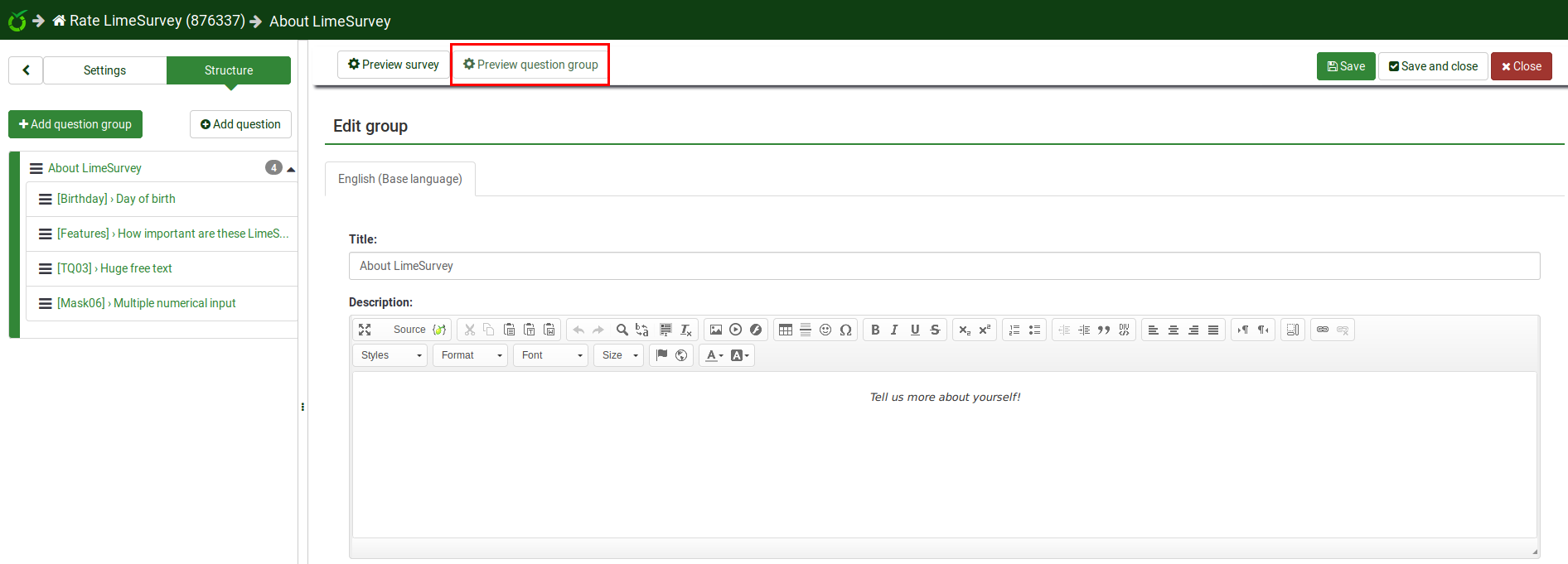
preview question group - question panel
The question group to which questions belong can be previewed from the question panel - see the top bar:
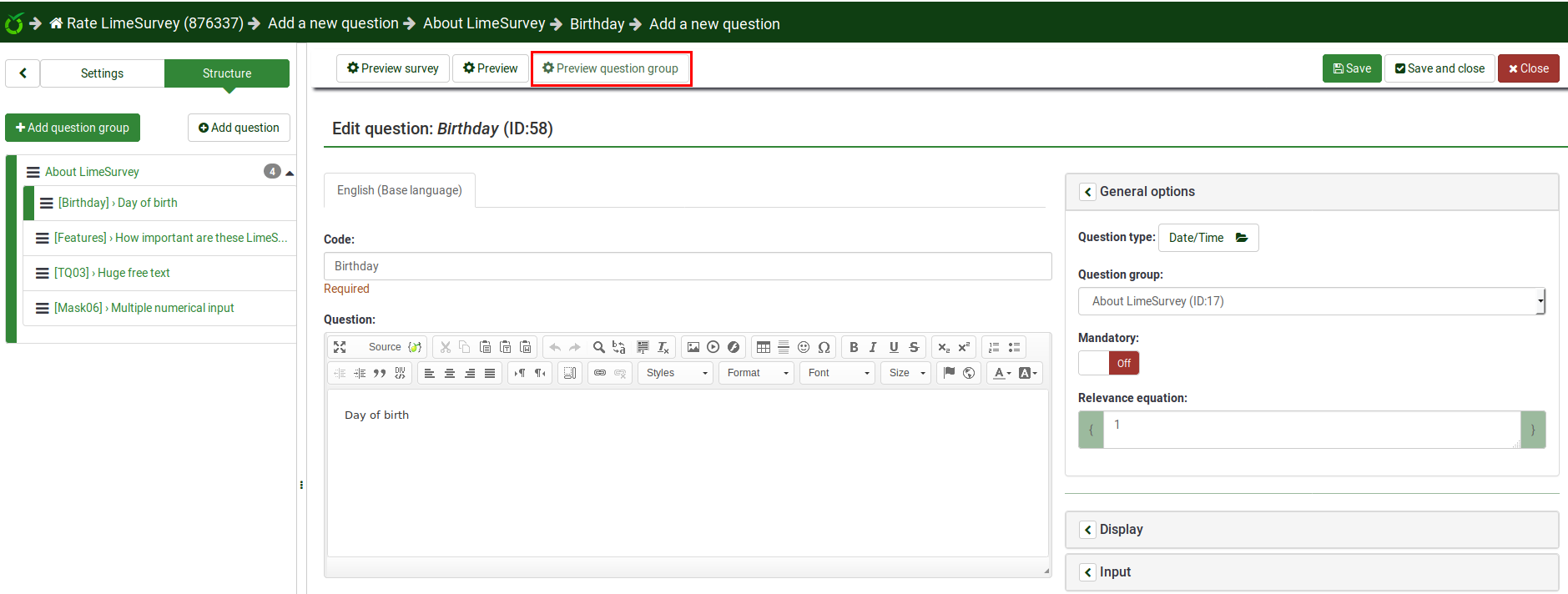
Reordering question groups
The question groups and questions can be reordered. For further details, read the survey structure wiki subsection.
Example
The relevance equation offers many possibilities to further customize your survey. A simple example is presented below to show how some question groups can be hidden according to the answer provided by the respondent to a prior question (part of another question group). For example, if you want to find out more information about parents that have one child in comparison to those with two or more, using the relevance equation to hide certain questions/question groups is recommended.
Link .lss file: Question_groups_simple_example.zip -> For instructions on how to import the file, refer to the following wiki section.
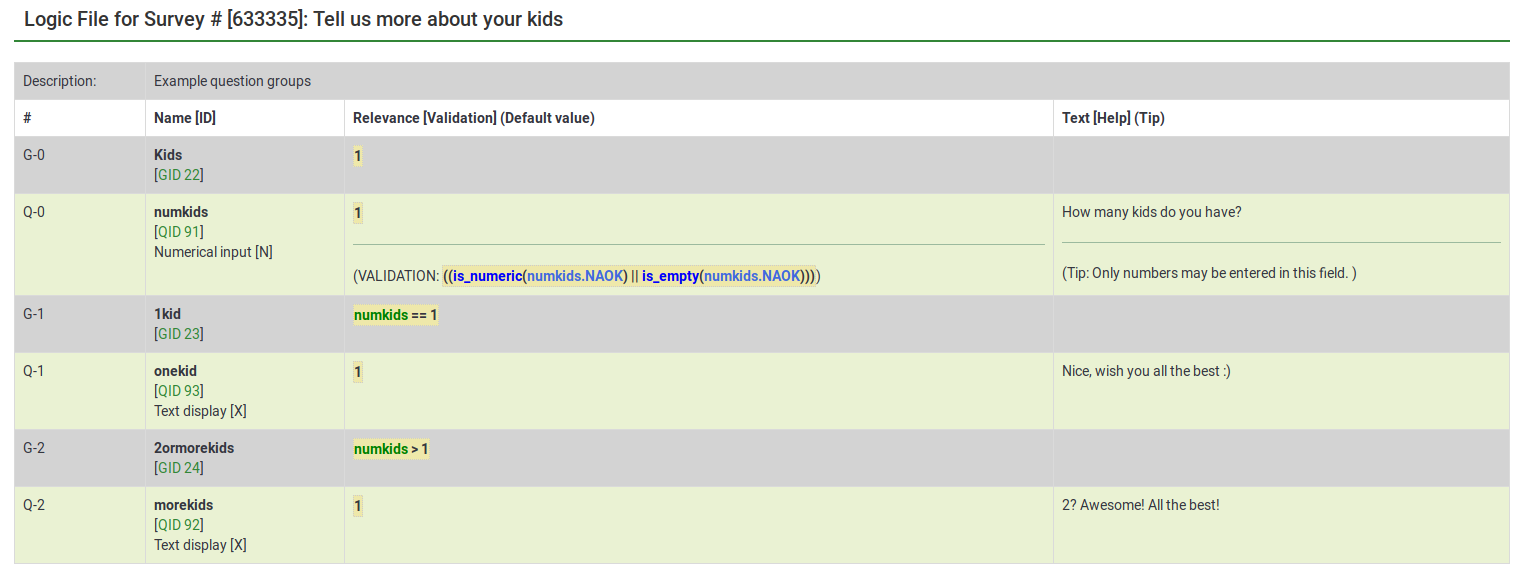
The above file contains three question groups, each containing one question. Question group "1kid" is displayed only if the value introduced by the respondent to the question "numkids" is 1. Question group "2ormorekids" is displayed only if the answer to the question "numkids" is >1.
This is just a simple example to show how expressions can be used to further customize your survey. For more details, please read about the ExpressionScript functionality.
- There are several ways to hide questions. One is to use conditions. However, for more complex surveys, the ExpressionScript has to be used.
- If you use expressions, don't forget to look for syntax errors with the help of the logic file.
